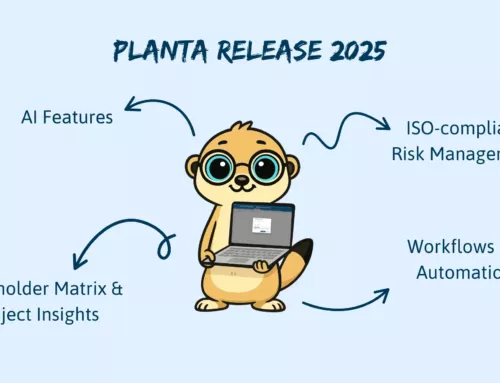Phases of Project Management: the 5 Project Phases in Detail
| Translated by Julian Hammer
Project phases are essential steps in project management: They help to lead a project systematically and efficiently to success. Each phase has its own objectives and entails specific tasks that affect the entire course of a project. By dividing a project into clearly defined phases, you can better monitor progress, identify risks at an early stage and ensure the quality of the results. A clear structure in project management also helps you to deploy resources in a targeted manner and react to changes in the project environment in good time.
The 5 phases of project management are:
- Project Start: Project objectives, resources and time frames are broadly defined followed by a first coordination with stakeholders.
- Project Planning: Project requirements, objectives and results are defined precisely and detailed plans (time, costs, resources, risks) are created.
- Project Implementation: The project is implemented according to the plan and tasks are processed.
- Project Monitoring: The project progress is continuously monitored and compared with the plan – control measures are taken in the event of deviations.
- Project Conclusion: All work is formally completed, results are submitted, experiences are documented and the project is concluded.
The project phases build on each other, with each phase forming the basis for the next. A clear structure is essential and helps to define objectives with precision, minimize risks and make efficient use of resources.
In the initial phase of a project, methods such as SWOT analysis or stakeholder analysis help to define the initial situation and needs with precision. In the planning phase, the Critical Path Method (CPM) or Gantt charts are used to structure schedules and resources in a meaningful way. During implementation and monitoring, progress is often checked using tools such as earned value analysis (EVA) so that adjustments can be made in good time.
Why is project management software important for the fulfillment of the phases? Good project management software is essential in every phase of the project. Not only does it support planning and documentation, it also facilitates control and communication within the team, enabling rapid and precise implementation across all project phases.
Traditional and agile methods often differ in terms of project phases. Traditional approaches such as the waterfall model often follow a clear, linear structure, while agile methods such as Scrum are iterative and more flexible. Despite different approaches, each phase influences the balance of the magic triangle in project management.

Table of Contents
- Project Phase: Project Start (Initialization)
- Project Phase: Project Planning (Definition & Planning)
- Project Phase: Project Implementation
- Project Phase: Project Monitoring (Steering)
- Project Phase: Project Conclusion (Closure)
- What Are the Advantages of Structured Project Management?
- How Do the 5 Phases of Project Management Differ in the Traditional and Agile Approach?
- Is There a Connection Between the 5 Phases of a Project and the Magic Triangle?
- Conclusion on the 5 Phases of a Project
- FAQ
1st Project Phase: Project Start (Initialization)
The first project phase lays the foundation for the entire project. In this start or initialization phase, an idea or a concrete need is turned into a formal project. The aim is to roughly outline the project objectives, define the expected benefits and identify the most important stakeholders. An initial assessment of feasibility (technical, economic, organizational) is also carried out. The results of this phase should be documented in a project order or project description and are essential for the subsequent in-depth planning of a project in the second phase.
A solid initialization phase is important because this is where you set the strategic course for the entire project. A clear vision and clearly formulated goals prevent the project from going in the wrong direction or the scope from getting out of hand later on.
The first steps usually include:
- Stakeholder analysis to understand the expectations and requirements of central interest groups
- Definition of superordinate project objectives
- First definition of a time frame
- Official appointment of the project manager
- Cost-Benefit Analysis
Typical mistakes in the first project phase include unclear or unrealistic objectives, a superficial analysis of stakeholder needs or underestimating the necessary resources and potential risks. To avoid these pitfalls, you should allow sufficient time to clarify the project brief, involve all relevant parties at an early stage and carry out an honest initial feasibility check. A clearly formulated and agreed project brief creates commitment and serves as a reference for the next phases.
2nd Project Phase: Project Planning (Definition & Planning)
The official project launch is followed by a detailed planning phase. This phase serves to define the path to reach the objective with precision – to do this, you define all the necessary steps, resources, costs and framework conditions. This is where the outline planning from the initiation phase is completed with concrete details: you work out and structure tasks, identify dependencies, draw up schedules, calculate costs, analyze risks and plan the required resources. Careful and comprehensive planning is the indispensable basis for successfully implementing and continuously monitoring a project.
The precise formulation of objectives and the definition of clear success criteria plays a central role in project planning. What exactly is to be achieved by what date, with what budget and in what quality? How is success measured? Methods like SMART objectives, CLEAR objectives or OKRs (Objectives and Key Results) help you to organize objectives in a specific, measurable, achievable, relevant and scheduled manner.
Through good planning you develop a realizable schedule that gives your team orientation and provides a solid basis for controlling. For successful project planning you should take the following criteria into account:
- project scope
- time available
- budget available
- quality expectations
- required resources (personnel, materials, finances)
- potential risks
Key planning tools support this process. The Work Breakdown Structure (WBS) breaks down the overall project into manageable work packages and creates transparency with regard to the entire project scope. Gantt charts visualize the schedule, show dependencies between tasks and are a key tool in time controlling. Furthermore, the resource planning is essential in this phase. Without realistic planning as to who will take on which tasks and when, and what resources are required, conflicts and delays are inevitable.
What Role Does Risk Management Play in the Second Project Phase?
The second phase is closely linked to the risk management in projects. What potential risks can jeopardize project success? How likely is their occurrence and what impact do they have? By systematically identifying and assessing risks, you can plan measures to avoid or mitigate them. This is also associated with resource management. Are the required employees with the necessary qualifications and material resources available at the right time? With the help of anticipatory resource planning, you can prevent bottlenecks and overloads during implementation. Both risk management and resource management are crucial to significantly increase the probability of the project’s success.

3rd Project Phase: Project Implementation
In the implementation phase, the carefully developed plans are put into practice. The project team works actively on the tasks defined in the WBS in order to achieve the project objectives. The actual value creation takes place in this project phase: the quality of the previous planning is now evident in the practical implementation.
The project team and their effective collaboration play a central role here. A clear distribution of tasks ensures that each team member knows their responsibilities, the expected results and deadlines. Regular team meetings (e.g. daily stand-ups or weekly status meetings), clear communication channels and the use of collaboration tools promote the flow of information and help to identify and solve problems at an early stage. Furthermore, an open and constructive feedback culture is essential.
In this phase, parts of the project can be steered using different methods. Operational tasks are often processed agilely with Kanban boards in the project teams, while the overall management continues to be carried out traditionally based on the waterfall model or via a Gantt chart.
Typical challenges in the implementation phase are:
- unexpected technical problems
- changes to the requirements by the customer
- resource conflicts (e.g. employees are required for other tasks)
- communication problems
Progress checks help you to keep an overview. Regular status reports, comparison with milestone deadlines or reviews of work results allow you to identify deviations from the plan at an early stage and initiate countermeasures in good time.
Why is a clear task distribution essential?
Unclear responsibilities inevitably lead to insufficiency and mistakes: Tasks are left undone, are processed twice or do not meet the quality requirements. This results in delays, increased costs, declining quality and frustration within the team. A clear assignment of tasks and responsibilities ensures that all necessary works are completed efficiently and promotes the successful implementation of a project.

4th Project Phase: Project Monitoring (Steering)
The fourth project phase runs simultaneously with implementation: the monitoring and steering phase. This phase is not a separate block after the third project phase, but accompanies it continuously. Its purpose is to measure the actual progress of the project based on the defined plans and to systematically identify deviations. If necessary, you can take corrective action to keep the project on track or realign it. The findings and decisions from this phase are decisive for the further course of the project and form the basis for the final project conclusion.
The monitoring phase is essential for project success, since it creates transparency. Without continuous monitoring, there is a risk of problems being identified too late, budgets being exceeded in an uncontrolled manner, deadlines not being met or quality defects being overlooked. By regularly checking the relevant parameters, project managers can act proactively. This enables you to make informed decisions and manage problems before they arise.
You can use various methods and key performance indicators (KPIs) to measure performance. Milestones serve as important checkpoints for checking milestones that are reached in the course of the project. Earned Value Management (EVM) is a comprehensive approach that puts the earned value and the actual costs in relation to each other. This not only shows the current status, but also enables forecasts for the further course of the project.
Which project controlling methods help with project management and monitoring?
Comparison: Traditional vs. Agile Procedure
Traditional (e.g. Waterfall)
- Detailed preliminary planning of the entire project (scope, time, costs).
- Sequential process: one phase follows the next.
- Plan is a reference; changes are formal and time-consuming.
- Focus on complete specification at the beginning.
Agile (e.g. Scrum)
- Rough vision at the beginning, detailed planning iteratively (per sprint/cycle).
- Incremental process: delivery of functional parts in short cycles.
- Plan is adaptive; changes are welcomed and integrated (backlog).
- Focus on early feedback and adaptation.
Traditional (e.g. Waterfall)
- Linear implementation of the planned work packages.
- Clear separation of roles and hierarchies.
- Documentation often centralized and downstream.
- Focus on adherence to the plan.
Agile (e.g. Scrum)
- Iterative development in fixed time frames (sprints).
- Self-organized, cross-functional teams.
- Continuous integration and delivery.
- Focus on collaboration and quick feedback.
Traditional (e.g. Waterfall)
- Little flexibility with regard to changes after the planning phase.
- Formal change request processes for adjustments.
- Risk that the end product no longer meets current requirements on completion.
Agile (e.g. Scrum)
- High adaptability thanks to short cycles and regular feedback.
- Changes can be easily incorporated into the backlog between sprints.
- Product is continuously adapted to current requirements.
Traditional (e.g. Waterfall)
- Control primarily via milestones and target/actual comparisons (plan vs. reality).
- Focus on adherence to time, budget and scope.
- Reporting often formal and periodic.
Agile (e.g. Scrum)
- Continuous monitoring through daily meetings (Daily Scrum), sprint reviews and retrospectives.
- Focus on progress (burndown charts), team speed and customer satisfaction.
- High level of transparency in the team.
Traditional (e.g. Waterfall)
- Software unterstützt v.a. bei detaillierter Planung (Gantt, PSP), Ressourcen- und Kostenmanagement.
- Focus on plan creation and tracking.
Agile (e.g. Scrum)
- Tools support backlog management, sprint planning, task boards (Kanban) and visualization of progress.
- Focus on team collaboration and transparency.
Modern project management software such as PLANTA Project often offers the best of both worlds. It allows for both structured, traditional planning and control as well as for agile implementation of task packages with integrated tools such as Kanban boards. You can thus choose hybrid approaches that best suit your project.
Common techniques in project controlling support monitoring and steering. This includes target/actual comparisons (e.g. costs and deadlines), trend analyses (e.g. milestone trend analysis) and forecast calculations. Here are two examples of a traditional and an agile method:
- Milestone Trend Analysis (traditional method): Is used to graphically display the planned and forecast deadlines for defined milestones over the course of the project. This allows you to identify and analyze trends (e.g. constant delays in certain work packages) at an early stage. This allows you to make a well-founded forecast of the project end date.
- Earned Value Analyse (agile method): Originally, the EVA was a traditional project controlling method that compares the degree of completion with the costs of a project. In agile projects, instead of the financial aspect (project budget), the time deviation from the original project plan is compared (actual vs. planned expenditure). The EVA is ideal for agile projects, since as changing requirements can quickly lead to a new total expenditure for the calculation of deviations.
Which project controlling methods are used strongly depends on the type of project and the chosen process methodology – all have their specific advantages and disadvantages.
| Controlling method | Advantages | Disadvantages |
|---|---|---|
| Milestone Trend Analysis |
|
|
| Earned Value Analysis |
|
|
5th Project Phase: Project Conclusion (Closure)
The fifth and final project phase is the formal project conclusion (closure). This phase marks the official end of the project and ensures that all agreed work is completed and the project results are formally handed over to the relevant stakeholders. A comprehensive final report summarizes the key project data (including goals achieved, successes, challenges and significant deviations from the original plan).
It is important to document and evaluate the experience gained: A structured conclusion ensures the long-term success of the project and enables valuable organizational learning. The results of this phase, in particular the lessons learned and final reports are used as a knowledge base for the launch of new projects.
Unfortunately, follow-up is often neglected in practice – especially if the team is already moving on to the next project or the project was not successful. The consequences are severe: valuable knowledge gained from experience is lost and the same mistakes are repeated in subsequent projects. In addition, there is often no clear handover, which can lead to ambiguities in the use or maintenance of the project results. Incomplete closure can also have a negative impact on the team’s motivation.
For an effective closure analysis you should plan sufficient time and resources. Use structured formats and moderation techniques for the lessons learned (e.g. questionnaires, moderated workshops with a clear agenda). Don’t just focus on problems, but also specifically identify success factors and best practices. This also includes optimizing existing templates and using the experience gained to adapt effort estimates for future, similar projects.
It is crucial to document the findings in concrete terms and define responsibilities for implementing improvement measures. By actively making the knowledge accessible, it can actually be used in the relevant phases of future projects and thus provide added value in the long term.
What Are the Advantages of Structured Project Management?
Professional, structured approach along the defined phases increases the probability of project success significantly. It goes far beyond the mere processing of tasks and offers clear advantages to both companies and the stakeholders involved:
- improved predictability
- transparency and control over strategic and initiatives
- more efficient allocation and use of resources
- reduction of project risks
- higher quality of the project results
- increased customer and stakeholder satisfaction
Standardized processes, as promoted by the application of the project management phases not only improve the comparability of projects: They also facilitate portfolio management and enable well-founded decisions to be made at management level. Numerous studies, e.g. by Project Management Institute (PMI) show time and again that organizations with a high level of maturity in project management are much more likely to achieve their project objectives.
There are also tangible benefits for the project teams. Clear structures, defined roles and responsibilities and transparent communication channels reduce uncertainty, misunderstandings and stress. The division into phases creates clear milestones, the achievement of which has a motivating effect and conveys a sense of progress. A systematic approach promotes effective cooperation. This allows the team to concentrate on the content-related challenges instead of dealing with organizational chaos.
Powerful project management software plays a decisive role in the successful implementation of all project phases. Not only does it support planning, control and documentation, but it also promotes teamwork. By providing relevant information centrally and up-to-date, it helps to establish standards throughout the entire project life cycle.
All Project Phases at a Glance with the PLANTA Project Project Management Software
The consistent application of the five project phases ensures that your projects are structured, comprehensible and efficient. Professional software solutions like the PLANTA Project project management software can provide substantial support for you and your team throughout the course of a project. This will help you master the typical challenges of each phase.
From the recording and evaluation of project proposals during initialization to detailed planning with powerful tools (e.g. interactive Gantt charts for scheduling, WBS and integrated resource and cost management), PLANTA Project offers the necessary functions for a solid basis. In the implementation phase, the software facilitates the assignment and tracking of tasks (via integrated Kanban boards for hybrid approaches), supports time recording and promotes team-internal communication. Meaningful reports and customizable dashboards ensure continuous monitoring, allowing you to always have an eye on the project status. Finally, the software also helps with project completion by providing functions for central documentation, final reports and archiving. PLANTA Project helps you to efficiently master the steps in project management and secure sustainable project success.

How Do the 5 Phases of Project Management Differ in the Traditional and Agile Approach?
Although the basic process is the same for both approaches, the specific characteristics of the project phases differ significantly between traditional and agile project management.
- Traditional project management: Here, the five phases of a project are usually completed in a strictly sequential manner. One phase must therefore be substantially completed before the next phase begins. The focus is on detailed and complete advance planning, which should be implemented as precisely as possible during execution. Changes to the plan once defined are undesirable, often costly and are managed via formal change request processes. Monitoring focuses heavily on checking compliance with the original plan. This approach is well suited for projects with clear, stable requirements and a low level of uncertainty.
- Agile project management: Agile approaches work iteratively and incrementally. Although there is also a kind of initialization (e.g. product vision, initial product backlog) and a formal conclusion (e.g. release), all further phases merge and are repeated in short cycles (iterations or sprints, typically 1-4 weeks). In each cycle, a small part of the overall product is planned, developed, tested and presented to the stakeholders (review), after which feedback is obtained. Planning is adaptive and continuous; the backlog is regularly adjusted. Monitoring takes place almost daily (e.g. Daily Scrum) and at the end of each cycle (Sprint Review, Retrospective). Agility is particularly suitable for projects with changing requirements, high complexity or great uncertainty.
Hybrid models often try to combine the strengths of both approaches, e.g. by a traditional framework planning and agile implementation of work packages.
Is There a Connection Between the 5 Phases of a Project and the Magic Triangle?
The magc triangle of project management illustrates the fundamental conflicts of objectives and dependencies between the three primary control variables of each project: Time, Costs and Performance. Every decision, every activity and every event within the project phases inevitably influences this delicate balance.
The way you manage the phases of a project has a direct and often immediate impact on the dimensions of the magic triangle – here are two examples:
- Start & Planning (Phase 1 & 2): In these early phases, the key points of the magic triangle are significantly defined and determined. Here you determine the initial time frame, calculate the required budget and define the scope of services and quality requirements in detail. Unrealistic planning in this phase (e.g. too tight deadlines, underestimated costs, unclear requirements) almost inevitably leads to problems and conflicting objectives as the project progresses.
- Implementation & Monitoring (Phase 3 & 4): During these phases, an attempt is made to fulfill the targets defined in the planning and at the same time keep the magic triangle in balance. However, if unforeseen events occur (e.g. technical difficulties, new requirements), deviations from the plan arise. Every necessary control measure then influences at least one dimension of the triangle: Accelerating the project to meet a deadline often causes additional costs (e.g. for overtime) or requires compromises in quality. A budget cut can lead to longer terms or a reduction in the scope of services.
The targeted management of project phases, including transitions between them is therefore the decisive lever for actively controlling the balance in the magic triangle. In this way, you can make conflicts of objectives transparent and complete the project successfully and in line with the client’s priorities despite unavoidable challenges.
Conclusion on the 5 Phases of a Project
The breakdown of a project into the five central project phases – start, planning, implementation, monitoring and completion – forms the backbone of successful project management. This structured project process creates the necessary transparency, enables targeted control and helps to identify and manage risks at an early stage.
Regardless of whether you use traditional, agile or hybrid methods: Understanding and carefully processing these phases in project management, ideally supported by professional project management software, are decisive for achieving your project objectives.
FAQ
How to Measure Project Success Across All Phases?
Project success is measured by continuously monitoring KPIs relating to time, costs, scope and quality. Methods such as target/actual comparisons, milestone trend analyses, earned value management and regular reviews help to objectively assess progress and determine the degree of target achievement.
How Does a Work Breakdown Structure Help with the Project Management Phases?
The WBS is in the planning phase (Phase 2). It divides the project objective hierarchically into deliverable results and work packages. This creates clarity about the entire scope and forms the indispensable basis for the detailed planning of deadlines, costs and resources as well as for the distribution of tasks and progress control in the implementation and monitoring phase (phase 3 & 4).
What Typical Mistakes Happen in the 5 Phases of Project Management?
Typical mistakes are: unclear goals or lack of commitment at the start (phase 1), unrealistic time or resource planning (phase 2), poor communication or unclear responsibilities (phase 3), delayed recognition of deviations due to insufficient monitoring (phase 4) and neglecting the lessons learned at the end (phase 5).
Project Steering with PLANTA Project
The right project management software allows you to steer projects more easily.
This blog post has been translated by Julian Hammer
Related Posts
RECENT POSTS
Kanban in Project Management: Definition, Principles, Advantages, and Limitations
Beate Schulte2025-12-11T06:40:23+00:0015. October 2025|
What are the 10 best multi-project management software solutions in 2025?
Jochen Geißer2025-12-11T06:43:55+00:0014. October 2025|
What is Earned Value Management (EVM)? Definition, Key Figures, Advantages and Limitations
Jochen Geißer2025-12-11T06:47:21+00:009. October 2025|














